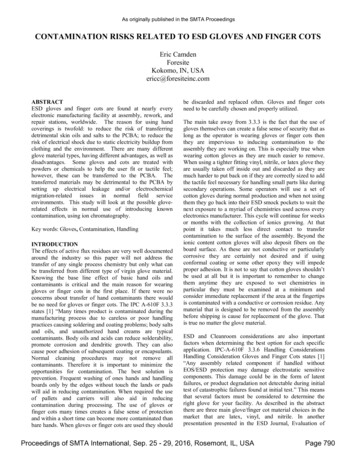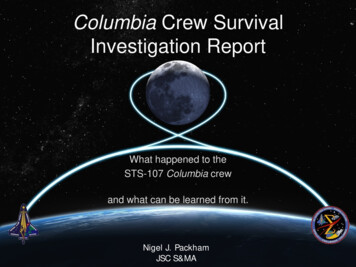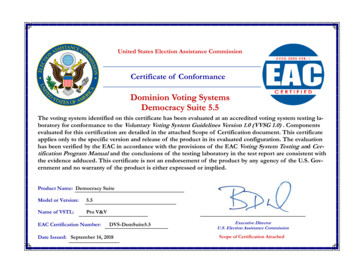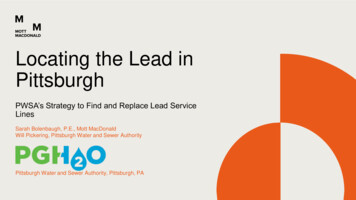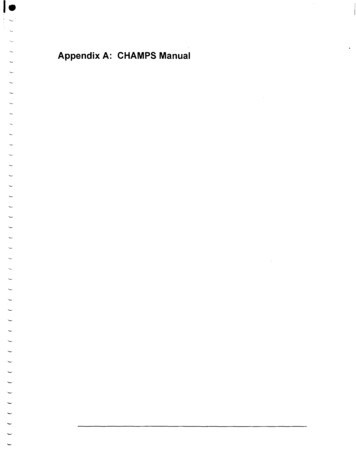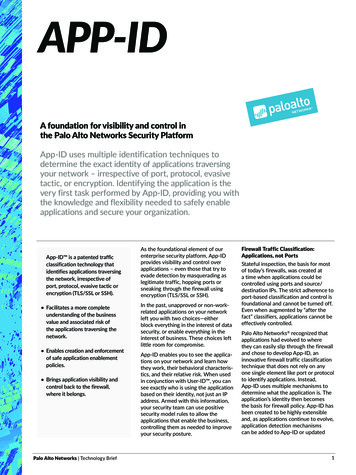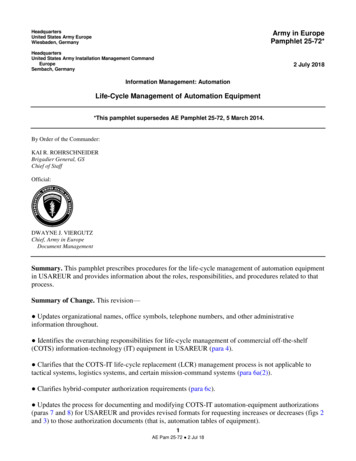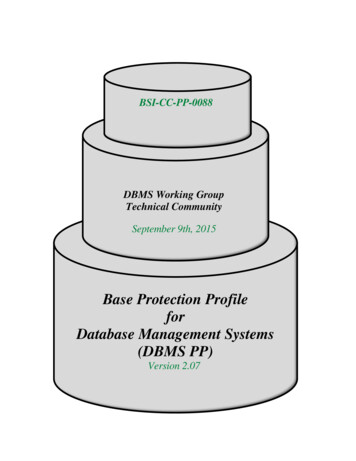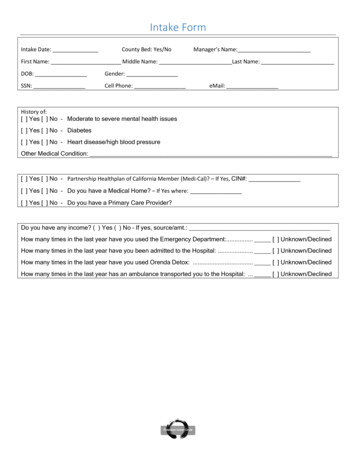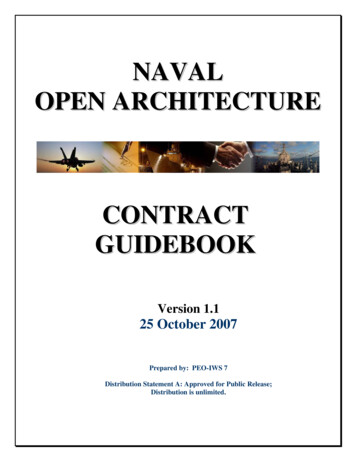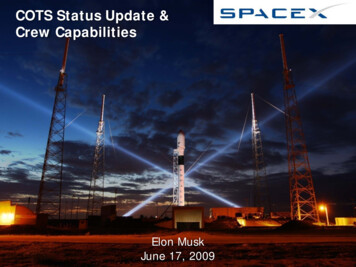
Transcription
COTS Status Update &Crew Capabilities6/22/2009Elon MuskJune 17, 20091
SpaceX Overview Founded in 2002 with the singular goal of providinghighly reliable, low cost space transportation– Expand into human transportation once technology is proven800 employees — growing 50% per yearFacilities: 550,000 sqft of offices, manufacturing & productionin Hawthorne, CA 300 acre state-of-the-art Propulsion and StructuralTest Facility in central Texas Launch sites at Kwajalein & Cape CanaveralHawthorne HeadquartersJune 16, 2009Central TexasSpace Exploration Technologies CorpKwajaleinSLC-40, Cape Canaveral2
SpaceX ManifestCustomerLaunchVehicleDeparture PointQ3 2009Falcon 1KwajaleinFalcon 9 Maiden Flight2009Falcon 9Cape CanaveralNASA COTS - Demo C12010Falcon 9/DragonCape CanaveralAvanti Communications (UK)2010Falcon 9Cape CanaveralNASA COTS - Demo C22010Falcon9/DragonCape CanaveralMDA Corp (Canada)2010Falcon 1KwajaleinNASA COTS - Demo C32010Falcon9/DragonCape CanaveralNASA CRS12010Falcon 9/DragonCape CanaveralDragonLab Mission 12010Falcon 9/DragonCape CanaveralSwedish Space Corp. (Sweden)2011Falcon 1KwajaleinBigelow Aerospace2011Falcon 9Cape CanaveralNASA CRS22011Falcon 9/DragonCape CanaveralDragonLab Mission 22011Falcon 9/DragonCape CanaveralCONAE 1A (Argentina)2012Falcon 9KwajaleinCONAE 1B (Argentina)2013Falcon 9Kwajalein2012-15Falcon 9/DragonCape CanaveralATSB (Malaysia)NASA CRS3-12(10 additional missions)Falcon 1 commercialJune 16, 2009Falcon 9 commercialCOTS DemoSpace Exploration Technologies CorpISS Cargo DeliveryDragonLab3
Falcon 1 Status Reached orbit Sept 28, 2008 Next launch July 2009 Launch facility on Omelek Island,Kwajalein Atoll World’s lowest-cost dedicatedorbital mission Substantial Lessons-Learned &feed-forward for Falcon 9 vehicleAll structures, engines, most avionics and allground systems designed (and mostly built) bySpaceXJune 16, 2009Space Exploration Technologies Corp4
Falcon 1 Flight 5 on OmelekJune 16, 2009Space Exploration Technologies Corp5
Falcon 9 Status Inaugural mission Q4 2009 5x cost reduction compared todomestic competitors Designed from inception for crewtransportation– Simple, high-reliability architecture– Engine-out reliability, similar toSaturn I & V– Meets NASA crew-rated safetymargins and failure tolerancesAll structures, engines, most avionics and all groundsystems designed (and mostly built) by SpaceXJune 16, 2009Space Exploration Technologies Corp6
Falcon 9 Status - MerlinFull Mission-Duration (360 second) Test of Merlin-VacuumEngine for Falcon 9 2nd StageAcceptance Test of Flight Merlin Engine(Qualification complete)June 16, 2009Space Exploration Technologies Corp7
Falcon 9 Status: 9-Engine Tests1st Stage Full DurationStatic Fire (177 seconds)11/22/08View of 9 engines post-test, includingheat shield/close-out panelsJune 16, 2009Space Exploration Technologies Corp8
Falcon 9 Status - MerlinFalcon 9 Engines, Truss & SkirtMerlin Production LineJune 16, 2009Space Exploration Technologies Corp9
Falcon 9 StatusFalcon 9 Lithium-PolymerBattery in QualificationTestingFalcon 9 Flight 2nd & 1st StagesFalcon 9 1st Stage & Interstage inQualification TestingJune 16, 2009Merlin Engine Controller onQualification EngineSpace Exploration Technologies CorpFalcon 9 Skirt & Truss inQualification Test Stand10
Falcon 9 on launch padSLC-40 Cape Canaveral, January 20096/22/2009Space Exploration Technologies Corp11
Cape Canaveral Launch Site125k Gal. LOX TankPneumaticsRP-1 Fuel Tanks & SkidsPadFlame BucketExhaustRP-1LOXJune 16, 2009Space Exploration Technologies Corp12Integration Hangar
Dragon Status Inaugural mission Q1 2010 1st flight Qualification testing90% complete 1st flight hardware infabrication Designed from inception forcrew transportation– Meets NASA crew-rated safetymargins and failure tolerancesAll structures, engines, most avionics and all groundsystems designed (and mostly built) by SpaceXJune 16, 2009Space Exploration Technologies Corp13
Dragon StatusDragon Acoustic TestingJune 16, 2009Dragon Structure in Qualification TestingSpace Exploration Technologies Corp14
Dragon StatusNSA Certified Crypto ModuleDraco Thruster in Qualification TestingPropellant Tank in QualJune 16, 2009Draco Flight ThrustersSpace Exploration Technologies Corp15
Dragon StatusQualification Li-P BatteryDemo C1 Flight Unit in FabricationPrimary Heatshield Tile Lay-upJune 16, 2009PICA-X Flight TileSpace Exploration Technologies CorpDemo C1 Forward Bulkhead Flight UnitThermal Control Pump in Qual16
CUCU Status COTS UHF Communications Unit– UHF cross-link with ISS– Dragon health & status telemetry ISS crew– Basic commands from ISS crew Dragon Flight Unit for ISS installation on-trackfor delivery to NASA this monthCUCU in Qualification Test– In Qualification testing Crew Command Panel– Completed Human Factors Review– In Qualification testingJune 16, 2009Space Exploration Technologies CorpCrew Command Panel17
DragonEye LIDAR Status DragonEye is primary prox-ops sensor onDragon DTO payload on STS-127 (currently on pad) Will collect data during approach to ISS Substantial risk mitigationJune 16, 2009DragonEye DTO installed in shuttlecargo baySpace Exploration Technologies CorpDragonEye DTO Flight Unit18
ISS Integration Status Completed ISS Safety Review Panel (SRP) Phase 1 & most of 2– Phase 3 (final) scheduled early 2010 Cargo integration planning in-work with both COTS and CRSprograms Integration testing (including Joint Integration) is underway Also, end-toend tests ofintegratedSpaceX-NASAground systemsuccessfullycompletedJune 16, 2009Space Exploration Technologies Corp19
COTS Program Status Completed 14 of 22 milestones on schedule– Including all 3 financing rounds– Including SRR, PDR and CDR for each Demo– CUCU delivery scheduled for June 30th Some slips expected in remaining milestones– NASA has been fully informed regarding progress toward thesemilestones Demo flights now scheduled for:– Demo C1: January 2010 (2 months after inaugural F9 flight)– Demo C2: June 2010– Demo C3: Aug. 2010June 16, 2009Space Exploration Technologies Corp20
Crew Capability Both Dragon & Falcon 9 were designed frominception to readily accommodate crewThis is why SpaceX was founded Immediate focus is on cargo for COTS& CRS commitments, BUT In every design decision, the ability to attainhuman rating rapidly & at low additional cost isparamountNote: Many human-rating requirements aremandated on the cargo vehicle because it must besafe for ISS crewJune 16, 2009Space Exploration Technologies Corp21
Dragon Already Designed toAccommodate ISS Crew For COTS Capabilities A-C, astronauts will enter (and temporarilyinhabit) the Dragon spacecraft for loading and unloading of cargo toand from the International Space Station Therefore, Dragon already meets the manned requirements to allowthis activity, as called out in SSP 50808 Air sampling and circulation ISS crew sample Dragon’s air supply through the Air RevitalizationSystem (ARS) port before entering the spacecraft, breathing in theair as provided by the Dragon Environmental Control System. Air circulation is provided to ensure safe breathability throughout thespacecraft Temperature and humidity requirements Touch temperature limits: between 39 F and 113 F Human Factors Protection from shock Restrictions on sharp corners, sharp edges, exposed screw threads, burrs,and pinch points. All fonts, colors, and labels are consistent with SSP 50005.June 16, 2009Space Exploration Technologies Corp22
Additional Dragon Design FeaturesAdded for Crew Accommodation Factors of Safety: primary structures designed to 1.4 or 1.5 on ultimatefactors of safety per SSP 30559 (instead of 1.25) Driving Design Load Cases are specific to crewed missions:– Launch escape system ignition, burn & worst-case abort reentry– These loads are 30% higher than any loads potentially occurring on a cargo mission Usable Volume: Selected to accommodate at least 6 crew Fault Tolerance: At least 2-fault-tolerant, as required for human rating,including Flight Computers & Propulsion systems 3.5 g’s nominal reentry acceleration (similar to Gemini) Crew Egress: 2 hatches one opens outwards, the other inwards Three windows, even in cargo version Thermal Control System & radiator are sized for crew requirements 210 days orbital life span: Positive energy balance, lots of propellant forstation-keeping etc.June 16, 2009Space Exploration Technologies Corp23
Additional Development Requiredto Fly Crew Launch Escape System– Preliminary designs already defined– Leverages heavily off existing SpaceXdesigns and capabilities Crew Accommodations– Seats, monitoring & overrides Up-rate Environmental Control System tofull Life Support– Add CO2 & Humidity Control 2.5 years required for first crewed mission “Life-boat Dragon” (return only) capability could be achievedwithin 1.5 years and NASA is NOT the only customer June 16, 2009Space Exploration Technologies Corp24
Value of COTS (so far ) In under 4 years & 234M the SpaceX COTS program has achieved:–Retirement of major risks and established launch site for first all-American new launch vehicle in over 30 years Main engine qualification9-engine full-duration firing– Post-CDR-level spacecraft design– Near complete set of Qualification hardware for inaugural mission– Interface concurrence with ISS– In-house fabrication & qualification of primary heatshield material– Design & qualification of hypergolic thrusters & propellant tanks– Delivered ISS cross-link radio capability(and about to flight-test proximity-operations LIDAR sensor on ISS approach on STS-127) As a direct result, SpaceX could supply to NASA at extremely low-cost by aerospace standards:– PICA-X heatshield material– Merlin engines– Draco hypergolic thrusters & propellant tanks– NSA-certified communications en/decryption module– In-space cross-link communications transceiver (CUCU)– Proximity-operations LIDAR sensors (DragonEye)– Extremely small, light-weight S-band/TDRSS transceivers– Large-structure Friction-Stir Welding manufacturing capability & expertise– Highly flexible, low-cost avionics I/O module (RIOs) amongst other thingsRemarkable Return on Investment!June 16, 2009Space Exploration Technologies Corp25
COTS Benefits Commercial services & benefits derived from COTScould include:– Cargo ISS (currently under contract)– Crew ISS– Crew Rescue (“Life-boat Dragon”)– Components Constellation & other programs– Rendezvous, inspection & robotic servicing of spacecraftThe COTS paradigm delivers maximum results atminimum cost & riskJune 16, 2009Space Exploration Technologies Corp26
COTS is integral to ExplorationCommercial Crew/Cargo was always part of the planJune 16, 2009Space Exploration Technologies Corp27
COTS is Enabling by providinghousekeeping &logistics services,at commercialrates, allowingNASA to focuspersonnel,facilities &money on themain objective –the Moon &beyondEarth Moon Mars beyond June 16, 2009Space Exploration Technologies Corp28
Back-up SlidesBack-up SlidesJune 16, 2009Space Exploration Technologies Corp29
“Life-Boat” Dragon Dragon could be certified as a “lifeboat” to return ISS crew to Earth in anemergencyLifeboat Dragon would be launched without crew, berth with ISS (like CargoDragon), and remain on standby for crew rescue and returnLifeboat Dragon could be certified for this return trip independent of (and inparallel with) other crew system developments– Lead-time for Initial Operational Capability (IOC) to 18 months– By far, the biggest development for full crew capability is the Launch Escape System(LES). By launching Lifeboat Dragon empty the LES is not required. This allows US crew to be maintained on ISS without depending on RussianSoyuz vehicles for rescue– Shuttle would still be needed for crew delivery to ISS until Crewed Dragon comesonline 30 months after ATP– Remaining shuttle flights could be spaced out to cover the “Gap” (currently 9 months),or additional flights could be added Besides the shuttle, only Dragon can accommodate an entire ISS crew of 6Cargo Dragon will have proven itself capable of safe, autonomous return toEarth at least four times before a Lifeboat Dragon is even launchedJune 16, 2009Space Exploration Technologies Corp30
“Life-Boat” Dragon Lifeboat Dragon could actually be a simpler vehicle than CargoDragon– Would not require solar arrays (or possibly a radiator), due to shortmission duration– Cargo Dragon is already two-fault tolerant, as required for ISS safety The only significant developments are:– Upgraded Environmental Control to sustain crew for return trip duration– Crew accommodations (seats etc.) instead of cargo racks– Vehicle overrides and monitoring for the crew, as mandated by HumanRating Requirements Note: Dragon cargo vehicle is capable of fully autonomous return to Earth– Docking/berthing adapter capable of rapid departureAll other necessary capabilities are already provided by Cargo DragonJune 16, 2009Space Exploration Technologies Corp31
Design-to Standards NPR 8705.2B: Human-Rating Requirements for SpaceSystemsNASA Std 3000:Man-Systems Integration StandardsSSP 50005:ISS Flight Crew Integration StandardSSP 50808:ISS-COTS Interface Requirements DocumentSSP 50809:ISS to COTS Interface Control DocumentNASA STD 5001:Structural Design and Test Factors of safetyfor Spaceflight HardwareSSP 30559:ISS Structural Design and VerificationRequirements (ISS document which is oftenmore strict than human-rating documents)AFSPCMAN 91-710: Range Safety User Requirements (tailored)MIL-STD-1540:Test Requirements for Space VehiclesJune 16, 2009Space Exploration Technologies Corp32
Design-to StandardsStructures: NASA Standard 3000NASA Standard 5007NASA Standard 5017SSP 30233SSP 30550, Rev CSSP 30560, Rev ASSP 30558, Fracture Control Requirements for Space StationSSP 41000SSP 41004, Rev H and J (Parts 1 and 2)SSP 41167, Rev GSSP 42004, Rev HMIL-HDBK-5MIL-HDBK-7MIL-STD-1246MIL-STD-1522NSTS 08307NSTS 21000-IDD-ISSJSC 28918NASA PRC-6506AMS-QQ-A250/30AMS 2772DJune 16, 2009Space Exploration Technologies Corp33
Design-to StandardsPropulsion:FAA Guide to Verifying Safety Critical Structures for Reusable Launch VehiclesJANNAF LPS Test GuideMIL-STD-1522 - Standard General Requirements for Safe Design and Operation of Pressurized Missile and Space SystemsMIL-PRF-25508 - Propellant, Oxygen, LiquidMIL-DTL-25576 - Propellant, RP-1, LiquidMIL-PRF-25567 - Leak Detection Compound, Oxygen SystemsMIL-PRF-26539 - Propellants, Dinitrogen TetroxideMIL-PRF-27404 - Propellant, Monomethyl HydrazineMIL-PRF-27407 - Propellant Pressurizing Agent, HeliumMIL-C-38999 - Connectors, Electrical, Plug, Circular, Straight, Removal Crimp Contacts, Series IIIMSFC-STD-3029 - Selection of Metallic materials for Stress Corrosion Cracking Resistance in Sodium Chloride EnvironmentsNASA STD-5012 - Strength and Life Assessment Requirements for Liquid Fueled Space Propulsion System EnginesAS478 - Identification and marking MethodsIEST-STD-CC1246 - Product Cleanliness Levels and Contamination Control ProgramTT-I-735A - Isopropyl AlcoholAWS D17.1 - Specification for Fusion Welding for Aerospace ApplicationsAvionics:JPL-D-8545 Rev. D (EEE Derating Standard)NASA-STD-8739 (harnesses, soldering, staking etc.)IPC-2221 (Printed circuits)IPC-2222 (Printed circuits)IPC-6011 (Printed circuits)IPC-6012 (Printed circuits)IPC-A-610 Class III (Printed circuits)IPC-CC-830 (Printed circuits)GSFC Supplement S-312-P003 (Printed circuits)June 16, 2009Space Exploration Technologies Corp34
Design-to StandardsQuality Management System Standards:ISO 9001:2000 QMS StandardISO 10011-1, 2, 3 Guidelines for QMS AuditingISO 10012 Measurement management systemsAS9100B QMS Aerospace StandardAS9101 QMS AssessmentAS9102 First Article Inspection Requirements –Guidance documentANSI / ISO 1007 Guidance on Configuration MgtISO17025 Calibration and Testing Labs –Guidance documentProduction / Test / Certification:ASTM Standards, Specifications, Test Methods and guidance documentsAIA/NAS Standards and SpecificationsAMS Material Specifications for raw materialsSAE Aerospace Quality Standards and Material SpecificationsAWS – American Welding Society Standards – some examples belowAWS D17.1 Specification for Fusion Welding for Aerospace ApplicationsAWS B2.1 Standard for Welding Procedure and Performance QualificationAWS D1.1 / D1.2 Structural Steel Welding codeAWS QC1, standard for Certification of Welding InspectorsAMS 2681B Welding Electron BeamAMS 2700 Passivation of Corrosion Resistant MaterialsASME Boiler Codes B31.1 and section IXASNT-TC1A Qualification and Certification of NDT PersonnelMIL-STD 410 / NAS 410 Qualification and Certification of NDT PersonnelASTM E 164 Standard Practice for Ultra Sonic InspectionASTM 1742 Standard Practice for Radiography InspectionASTM E 1417 Standard Practice for Penetrant InspectionASTM E 1444 Standard Practice for Magnetic ParticleIEST-STD-CC1246 Contamination Control –Guidance documentAS478 Identification Marking MethodsJune 16, 2009Space Exploration Technologies Corp35
Design-to StandardsSafety:29CFR1910 OSHA regulationsSUBPART D - Walking Working Surfaces.21-.30 including guards for floor and wall openings as well as proper use of ladders.SUBPART E – Exit Routes, Emergency Action Plans, and Fire Prevention Plans.33 - .39 including exit routes and their designation and upkeep, emergency action plans which designate those routes,and fire prevention plans to avoid fires and the need to evacuate.SUBPART F – Powered Platforms, Manlifts, and Vehicle-Mounted Work Platforms.66 - .68 personal fall arrest systems are dealt with here.SUBPART G - Occupational Health and Environmental Control.94 - .98 occupational noise exposure, monitoring and control are included here.SUBPART H – Hazardous Materials.101 - .126 the proper handling of compressed gasses and flammable and combustible liquids, and the training requiredfor their safe use are here.SUBPART I – Personal Protective Equipment.132 - .138 this is one of the most important sections and provides key topics for our training programs.SUBPART J – General Environmental Controls.141 - .147 two very important areas are included here; Permit required confined spaces and Lockout/Tagout.SUBPART K – Medical and First Aid.151 - .152 Sets the minimum requirements for a first aid program which we meet and exceed with our placement ofAutomatic External Defibrillators in our facility and an on-going First Aid/CPR/AED training andcertification program with an internal company trainer, as well as full coverage with first aid kits andsupplies.SUBPART L – Fire Protection.155 - .165 includes sections on fire extinguishers, sprinkler systems and alarms systems.SUBPART N – Materials Handling and Storage.176 - .184 important sections on powered industrial trucks, forklifts, and overhead cranes. Our active complianceprogram includes an onsite trainer for initial and refresher classroom and hands- on training.SUBPART 0 – Machinery and Machine Guarding.211 - .219 details methods of compliance in this critical area.SUBPART P – Hand and Portable Power Tools and Other Hand Held Equipment.241 - .244 details the safe use and care of these vital workplace items.SUBPART Q – Welding, Cutting, and Brazing.251 - .255 details the requirements for all types of welding which we perform here.SUBPART S – Electrical.301 - .399 a very important section that lists requirements for design, installation and safe work around energizedelectrical components.SUBPART Z – Toxic and Hazardous Substances.901 - .1450 a huge section that contains one of the most important standards. Hazard Communication, .1200, affectseveryone throughout our business and is the topic of universal employee training.June 16, 2009Space Exploration Technologies Corp36
Design-to StandardsSpaceX Internal: Dragon RequirementsSpaceX Human Rating PlanSpaceX System Safety and Mission Assurance PlanSpaceX COTS Environments Document00002720 - Fastener Installation Torque Specification00005453 - Procedure for Orbital GTAW of Stainless Steeland Titanium Tubing 00006876 - Component Cleaning ProcessJune 16, 2009Space Exploration Technologies Corp37
300 acre state-of-the-art Propulsion and Structural Test Facility in central Texas Launch sites at Kwajalein & Cape Canaveral June 16, 2009. . Dragon could be certified as a "lifeboat" to return ISS crew to Earth in an emergency Lifeboat Dragon would be launched without crew, berth with ISS (like Cargo
